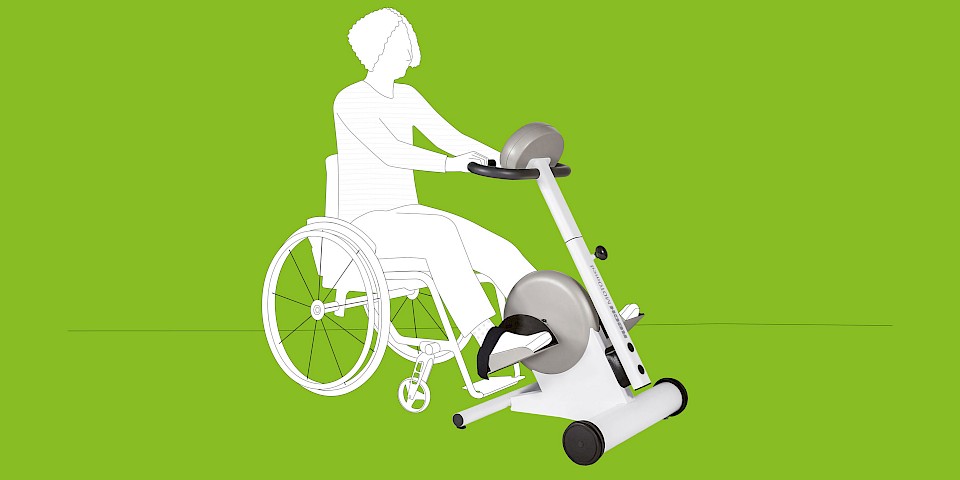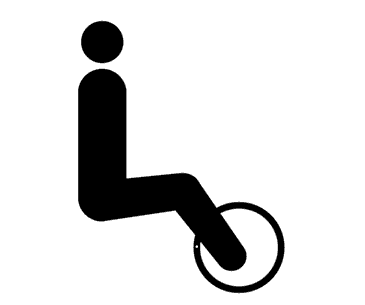Stroke
Relearning movement patterns
Special therapy methods that are based on an uniform and repetitive movement training play an important role in stroke rehabilitation. The frequent repetitions can stimulate the brain’s ability to reorganize itself. Consequently, healthy brain areas are able to acquire the functions of the affected areas. The controlled, smooth motion of the MOTOmed allows exactly this kind of repetitive movement training. Stroke patients can train with the passive movement therapy device from a chair or wheelchair with or without motor-assistance or in passive mode.
The movement therapy can help stroke patients to relearn lost movement patterns. Hand-/ and arm functions and the walking ability can be improved. The leg- and/or arm training can reduce spasticity, improve strength and endurance, positively influence bowel activity and assist coordination. MOTOmed functions and games motivate stroke patients to support the therapeutical treatment effectively at home with the MOTOmed movement therapy.
Scientifically examined
„The carried out study showed a clear influence of the MOTOmed®-movement therapy device for the improvement of the results from the 2-and 6-minutes- walk test, the comfortable walking-speed as soon as the necessary time for the Timed »Up&Go«-Test [note: clinical test for evaluation of the mobility and the risk of falling.]“
Source: Kamps A, Schüle K. Zyklisches Bewegungstraining der unteren Extremitäten in der Schlaganfallrehabilitation. Neurol Rehabil 2005; 11(5): 1-12.
Configure your personal MOTOmed
Use the MOTOmed Product Configurator to configure your MOTOmed according to your requirements. Quickly, easily and without obligation. Try it out and configure your personal and individualized MOTOmed now.
MOTOmed Movement Therapy
MOTOmed Movement Therapy was developed for people with movement restrictions and complements physical, ergo and sports therapy measures. Users can train while seated in a wheelchair or from a chair. Patients in supine position use MOTOmed from a nursing bed or therapy couch.
In Germany, the device-based movement therapy with the MOTOmed is recognized as an aid for many indications by the statutory health insurance. It is worthwhile to inform yourself!
Therapy modes
passive
The effortless motor driven movement is ideal for the regulation of muscle tone, loosening stiff muscles and for early mobilization after long rests. Passive training stimulates blood circulation, digestion and joint flexibility.
assistive
In motor-supported movement therapy, the function MOTOmed ServoCycling enables easy transition from passive to active training. A motor-supported movement stimulates strength and endurance even with minimal muscle strength.
active
An active training with own muscle power against finely adjustable resistance levels strengthens leg, arm and upper body muscles and stimulates the cardio-vascular system.
Achieving best therapy goals through interval training
Alternating phases of strain and recreation (intervals) through active and passive training give a higher training stimulus which leads to a better therapy success.
Therapeutic goals
- Promote walking
- Reduce the consequences of lack of movement
- Reduce spasticity
- Activate residual muscle strength
- Strengthen the psyche and well-being
- Counteract fatigue
Videos
Scientific studies and research results about the MOTOmed movement therapy in stroke patients
1.18) Hu Y., Tian J., Wen X., Lu C., Tian N. (2022). Clinical Effects of MOTOmed Intelligent Exercise Combined with Intensive Walking Training on the Rehabilitation of Walking, Nerve and Lower Limb Functions among Patients with Hemiplegia after Stroke, DOI: 10.12669/PJMS.38.5.5259
1.17) Minh D.N., Thanh V.T., Quoc V.N., Ninh K.N., Son T.V., Luu T.N., Linh V.P.D. (2023). Effectiveness on post-stroke hemiplegia in patients: electroacupuncture plus cycling vs electroacupuncture alone, DOI: 10.19852/J.CNKI.JTCM.2023.02.006
1.16) Simić Panić D., Spasojević T., Pantelinac S., Živanović Ž., Vojinović L., Tomašević T. (2024). The impact of cycling exercise on motor and functional recovery of patients in acute and subacute stroke phase, DOI: 10.2298/SARH231025032S
1.15) Kotov S.V., Isakova E.V., Sheregeshev V.I. (2020). Possibilities for Correcting Emotional and Behavioral Impairments in Stroke Patients during Rehabilitation Therapy. Neuroscience and Behavioral Physiology, 50, 156-161., DOI: 10.1007/s11055-019-00882-1
1.14) Shen C., Liu F., Yao L., Li Z., Qiu L., Fang S. (2018). Effects of MOTOmed movement therapy on the mobility and activities of daily living of stroke patients with hemiplegia: a systematic review and meta-analysis. Clinical rehabilitation, 32(12), 1569-1580., DOI: 10.1177/0269215518790782
1.13) Yang H.-C., Lee C.-L., Lin R., Hsu M.-J., Chen C.-H., Lin J.-H., Lo S.K. (2014). Effect of biofeedback cycling training on functional recovery and walking ability of lower extremity in patients with stroke. The Kaohsiung Journal of Medical Sciences, 30(1), 35-42., DOI: 10.1016/j.kjms.2013.07.006
1.12) Ambrosini E., Ferrante S., Pedrocchi A., Ferrigno G., Molteni F. (2011). Cycling Induced by Electrical Stimulation Improves Motor Recovery in Postacute Hemiparetic Patients: A Randomized Controlled Trial. Stroke, 42(4), 1068-1073., DOI: 10.1161/STROKEAHA.110.599068
1.11) Podubecka J., Scheer S., Theilig S., Wiederer R., Oberhoffer R., Nowak D.A. (2011). Zyklisches apparatives Bewegungstraining versus konventionelles Gangtraining in der Rehabilitation des hemiparetischen Ganges nach Schlaganfall: Eine Pilotstudie. Fortschritte der Neurologie Psychiatrie, 79(7), 411-418., DOI: 10.1055/s-0031-1273338
1.10) Skvortsova V.I., Ivanova G.E., Rumyantseva N.A., Staritsyn A.N., Kovrazhkina E.A., Suvorov A.Yu. (2011). Current Approaches to Restoring Walking in Patients during the Acute Phase of Cerebral Stroke. Neuroscience and Behavioral Physiology, 41(5), 536-541., DOI: 10.1007/s11055-011-9451-4
1.8) Dobke B., Schüle K., Diehl W., Kaiser T. (2010). Apparativ-assistive Bewegungstherapie in der Schlaganfallrehabilitation. Neurologie & Rehabilitation, 16(4), 173-185.
1.7) Eigler F. (2009). Funktionelle Elektrostimulation am Beinergometer in der Rehabilitation nach Schlaganfall: Der Einsatz funktioneller Elektrostimulation während des Trainings am zyklischen Beinbewegungstrainer (FES-LCE) in der stationären Rehabilitation nach zerebralem ischämischem Infarkt. Dissertation, Universität Heidelberg, Institut für Sport und Sportwissenschaft., DOI: 10.11588/heidok.00009950
1.6) Wan X., Gao C., Ye Z., Huang Z., Pan C. (2009). Einfluss des MOTOmed Beintrainings auf halbseitig gelähmte Schlaganfallpatienten. Chinese Journal of Physical Medicine and Rehabilitation, 31(7), 503-504.
1.5) Lennon O., Carey A., Gaffney N., Stephenson J., Blake C. (2008). A pilot randomized controlled trial to evaluate the benefit of the cardiac rehabilitation paradigm for the non-acute ischaemic stroke population. Clinical Rehabilitation, 22(2), 125-133., DOI: 10.1177/0269215507081580
1.4) Diserens K., Perret N., Chatelain S., Bashir S., Ruegg D., Vuadens P., Vingerhoets F. (2007). The effect of repetitive arm cycling on post stroke spasticity and motor control: Repetitive arm cycling and spasticity. Journal of the Neurological Sciences, 253 (1-2), 18-24., DOI: 10.1016/j.jns.2006.10.021
1.3) Bashir S. (2006). Rehabilitation of stroke and cerebellar patients. Thesis, Institute of Physiology, University of Fribourg.
1.2) Kamps A., Schüle K. (2005). Zyklisches Bewegungstraining der unteren Extremitäten in der Schlaganfallrehabilitation. Neurologie & Rehabilitation, 11(5), 259-269.
1.1) Demmer P.C. (2005). Überprüfung der Ausdauerfähigkeit von Schlaganfallbetroffenen durch ein apparativ-assistives Training. Diplomarbeit, Deutsche Sporthochschule Köln.











